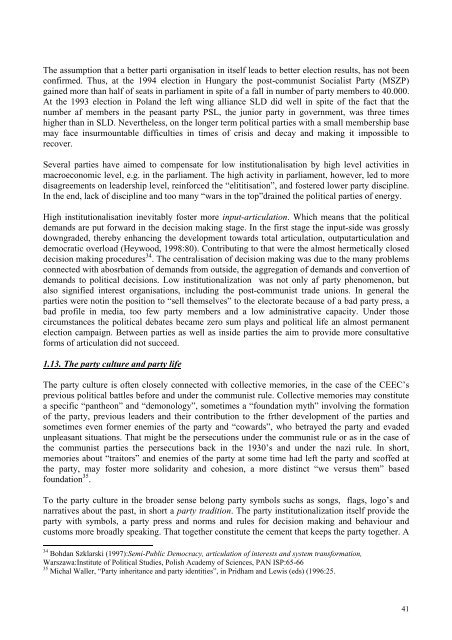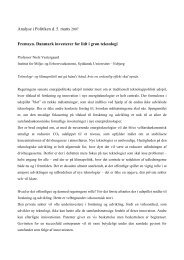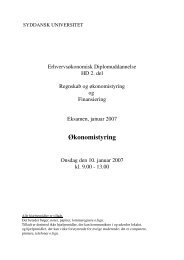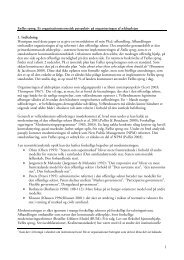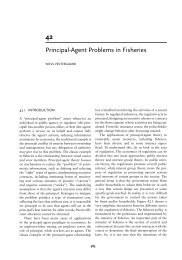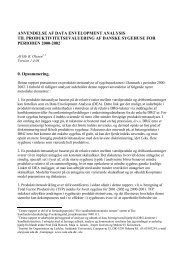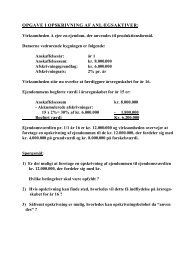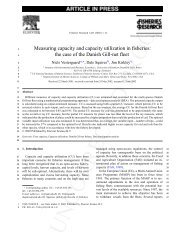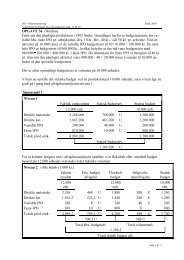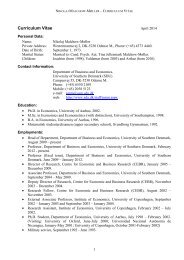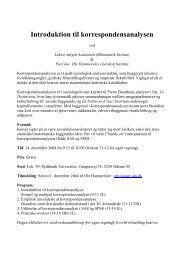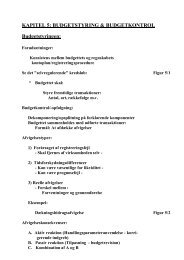political messages <strong>and</strong> slogans. Thus, <strong>in</strong>stitutionally the parties rem<strong>in</strong>ds us about the US type catchallelite or cadre parties.The heavy law mak<strong>in</strong>g burden moved parties towards post-communist type cartel parties. Withhigher <strong>in</strong>stitutionalisation more power was left over to the party apparatus, <strong>in</strong> this case smallpr<strong>of</strong>essional elite groups. Also political strategies <strong>and</strong> policy-mak<strong>in</strong>g were decided top-down.Unlike <strong>in</strong> the first stage, the parliamentary groups were not longer the most crucial decision mak<strong>in</strong>g<strong>and</strong> agenda-sett<strong>in</strong>g <strong>in</strong>stitutions. Under chang<strong>in</strong>g elite-voter l<strong>in</strong>kages <strong>in</strong>stitutionalisation tends to beweak <strong>and</strong> most non-communist parties aimed to appear as broadly based catch-all parties. Oppositeon the postcommunist Left. Thus after the departure <strong>of</strong> the “beton communists” the Polish left w<strong>in</strong>galliance SLD ga<strong>in</strong>ed a more functional organisation <strong>and</strong> at the same time a broader voter pr<strong>of</strong>ile.Like <strong>in</strong> western countries most parties preferred to appeal directly to the voters via the media <strong>and</strong>therby overlook the party structures <strong>and</strong> the party members 33 . The party congresses seemed toconcentrate the efforts on the <strong>in</strong>ternal elections to lead<strong>in</strong>g posts <strong>and</strong> personal matters, <strong>and</strong> the localparti organisations mostly constituted passive tools for top down decisions. However, the localparty organisations tended to ga<strong>in</strong> a certa<strong>in</strong> authonomy at least <strong>in</strong> local affairs, especially after theadm<strong>in</strong>istrative reforms <strong>and</strong> direct elections to local assemblies. In several countries, e.g. “localbarons” emerged. However, the central party apparatus were <strong>in</strong> possition <strong>of</strong> some means <strong>of</strong><strong>in</strong>tervention, e.g. at appo<strong>in</strong>tment <strong>of</strong> c<strong>and</strong>idates at elections <strong>and</strong> “screen<strong>in</strong>g” <strong>of</strong> the party members.Normally the organisational structure was at the same time vertical <strong>and</strong> horizontal with a three orfour levels <strong>of</strong> party organisation (municpial, district, regional <strong>and</strong> national). Unfortunately the wishto be a party member was modest, so most political parties did not constitute functional l<strong>in</strong>kagesbetween the political <strong>and</strong> the civil society arenas.The impact <strong>of</strong> low party <strong>in</strong>stitutionalization to some extent was reduced by polical learn<strong>in</strong>g. Mostparties established some special commitees or party annexes deal<strong>in</strong>g with subjects such as youthquestions, women <strong>and</strong> environment. Such as <strong>in</strong> most mass partiets. The Polish, Slovak <strong>and</strong>Hungarian political Right recognized that election could not be won primarily by use <strong>of</strong> symbolicpolitics <strong>and</strong> fragmentation. At the 1997 <strong>and</strong> 1998 parliamentary elections party alliances <strong>and</strong>embrella party constructions (AWS, SDK <strong>and</strong> FIDESZ-MDF) was set up <strong>in</strong> order to unite the forces<strong>and</strong> m<strong>in</strong>imize waste <strong>of</strong> votes. Most anticommunist alliances, e.g. AWS <strong>and</strong> SDK constitutednegative alliances without sufficient unity on policy <strong>and</strong> programme level <strong>and</strong> the necessarycohesion <strong>and</strong> loyalty on elite level.The low number <strong>of</strong> party members was not caused by the lack <strong>of</strong> <strong>in</strong>centives to become a partymember, the political parties themselves were not always <strong>in</strong>tested <strong>in</strong> maximiz<strong>in</strong>g the number <strong>of</strong>party members. In addition, the parties secured for themselves favourable f<strong>in</strong>ancial ressources dueto <strong>in</strong>creas<strong>in</strong>g subsidies from the state, thereby at least to some extent mak<strong>in</strong>g fees from partymembers <strong>in</strong>significant. Many members may also mean more conflicts <strong>in</strong>side the parties, which werenot kept together thanks to a common party history <strong>and</strong> common ideologies <strong>and</strong> party programmes.In a new TV <strong>and</strong> IT world party members do not longer play a crucial role as the mean <strong>of</strong>communication with the voters (Wightman, <strong>in</strong> White, Batt <strong>and</strong> Lewis (eds), 1998:163) <strong>in</strong> electioncampaigns.33 Miroslawa Grabowska, “Political <strong>Parties</strong>: Social Representative or Agent <strong>of</strong> Change”, Polish Sociological Review 4(116), 1996:307-322.40
The assumption that a better parti organisation <strong>in</strong> itself leads to better election results, has not beenconfirmed. Thus, at the 1994 election <strong>in</strong> Hungary the post-communist Socialist <strong>Party</strong> (MSZP)ga<strong>in</strong>ed more than half <strong>of</strong> seats <strong>in</strong> parliament <strong>in</strong> spite <strong>of</strong> a fall <strong>in</strong> number <strong>of</strong> party members to 40.000.At the 1993 election <strong>in</strong> Pol<strong>and</strong> the left w<strong>in</strong>g alliance SLD did well <strong>in</strong> spite <strong>of</strong> the fact that thenumber af members <strong>in</strong> the peasant party PSL, the junior party <strong>in</strong> government, was three timeshigher than <strong>in</strong> SLD. Nevertheless, on the longer term political parties with a small membership basemay face <strong>in</strong>surmountable difficulties <strong>in</strong> times <strong>of</strong> crisis <strong>and</strong> decay <strong>and</strong> mak<strong>in</strong>g it impossible torecover.Several parties have aimed to compensate for low <strong>in</strong>stitutionalisation by high level activities <strong>in</strong>macroeconomic level, e.g. <strong>in</strong> the parliament. The high activity <strong>in</strong> parliament, however, led to moredisagreements on leadership level, re<strong>in</strong>forced the “elititisation”, <strong>and</strong> fostered lower party discipl<strong>in</strong>e.In the end, lack <strong>of</strong> discipl<strong>in</strong>e <strong>and</strong> too many “wars <strong>in</strong> the top”dra<strong>in</strong>ed the political parties <strong>of</strong> energy.High <strong>in</strong>stitutionalisation <strong>in</strong>evitably foster more <strong>in</strong>put-articulation. Which means that the politicaldem<strong>and</strong>s are put forward <strong>in</strong> the decision mak<strong>in</strong>g stage. In the first stage the <strong>in</strong>put-side was grosslydowngraded, thereby enhanc<strong>in</strong>g the development towards total articulation, outputarticulation <strong>and</strong>democratic overload (Heywood, 1998:80). Contribut<strong>in</strong>g to that were the almost hermetically closeddecision mak<strong>in</strong>g procedures 34 . The centralisation <strong>of</strong> decision mak<strong>in</strong>g was due to the many problemsconnected with abosrbation <strong>of</strong> dem<strong>and</strong>s from outside, the aggregation <strong>of</strong> dem<strong>and</strong>s <strong>and</strong> convertion <strong>of</strong>dem<strong>and</strong>s to political decisions. Low <strong>in</strong>stitutionalization was not only af party phenomenon, butalso signified <strong>in</strong>terest organisations, <strong>in</strong>clud<strong>in</strong>g the post-communist trade unions. In general theparties were not<strong>in</strong> the position to “sell themselves” to the electorate because <strong>of</strong> a bad party press, abad pr<strong>of</strong>ile <strong>in</strong> media, too few party members <strong>and</strong> a low adm<strong>in</strong>istrative capacity. Under thosecircumstances the political debates became zero sum plays <strong>and</strong> political life an almost permanentelection campaign. Between parties as well as <strong>in</strong>side parties the aim to provide more consultativeforms <strong>of</strong> articulation did not succeed.1.13. The party culture <strong>and</strong> party lifeThe party culture is <strong>of</strong>ten closely connected with collective memories, <strong>in</strong> the case <strong>of</strong> the CEEC’sprevious political battles before <strong>and</strong> under the communist rule. Collective memories may constitutea specific “pantheon” <strong>and</strong> “demonology”, sometimes a “foundation myth” <strong>in</strong>volv<strong>in</strong>g the formation<strong>of</strong> the party, previous leaders <strong>and</strong> their contribution to the frther development <strong>of</strong> the parties <strong>and</strong>sometimes even former enemies <strong>of</strong> the party <strong>and</strong> “cowards”, who betrayed the party <strong>and</strong> evadedunpleasant situations. That might be the persecutions under the communist rule or as <strong>in</strong> the case <strong>of</strong>the communist parties the persecutions back <strong>in</strong> the 1930’s <strong>and</strong> under the nazi rule. In short,memories about “traitors” <strong>and</strong> enemies <strong>of</strong> the party at some time had left the party <strong>and</strong> sc<strong>of</strong>fed atthe party, may foster more solidarity <strong>and</strong> cohesion, a more dist<strong>in</strong>ct “we versus them” basedfoundation 35 .To the party culture <strong>in</strong> the broader sense belong party symbols suchs as songs, flags, logo’s <strong>and</strong>narratives about the past, <strong>in</strong> short a party tradition. The party <strong>in</strong>stitutionalization itself provide theparty with symbols, a party press <strong>and</strong> norms <strong>and</strong> rules for decision mak<strong>in</strong>g <strong>and</strong> behaviour <strong>and</strong>customs more broadly speak<strong>in</strong>g. That together constitute the cement that keeps the party together. A34 Bohdan Szklarski (1997):Semi-Public Democracy, articulation <strong>of</strong> <strong>in</strong>terests <strong>and</strong> system transformation,Warszawa:Institute <strong>of</strong> Political Studies, Polish Academy <strong>of</strong> Sciences, PAN ISP:65-6635 Michal Waller, “<strong>Party</strong> <strong>in</strong>heritance <strong>and</strong> party identities”, <strong>in</strong> Pridham <strong>and</strong> Lewis (eds) (1996:25.41
- Page 3: “This provisional situation chara
- Page 6 and 7: marketisation and privatisationshor
- Page 8 and 9: purposes, are channels for “expre
- Page 10 and 11: the significance of strategic choic
- Page 12 and 13: presidentialism gave rise to “flo
- Page 14 and 15: antipolitics and reinforcement of a
- Page 16 and 17: In the late 1990’s elections most
- Page 18 and 19: determined primarily by “politica
- Page 20 and 21: politics and antipolitics, all sign
- Page 22 and 23: which attitudes to state regulation
- Page 24 and 25: Anti-communism has been defined in
- Page 26 and 27: elections and the Slovak communists
- Page 28 and 29: Cartel agreementsbetter representat
- Page 30 and 31: Basically the absence of clear cons
- Page 32 and 33: After 1989 different types of polit
- Page 34 and 35: complex project for transition unde
- Page 36 and 37: window of opportunity in spite of s
- Page 38 and 39: analyses of party institutionalizat
- Page 42 and 43: well established party culture may
- Page 44 and 45: expected, much due to the many spli
- Page 46 and 47: Furthermore, the polarisation on el
- Page 48 and 49: Finally, Solidarity can also be con
- Page 50 and 51: whole, on the one side an authorita
- Page 52 and 53: The economic recession and the grav
- Page 54 and 55: election defeat more cooperation an
- Page 56 and 57: The formation of AWS can be conside
- Page 58 and 59: group. RS AWS constituted the Chris
- Page 60 and 61: According to the original plans the
- Page 62 and 63: values. According to Rybicki, as so
- Page 64 and 65: AWS should fight against all types
- Page 66 and 67: 2001 parliamentary election, howeve
- Page 68 and 69: and workers voted ZChN. At the 1993
- Page 70 and 71: The League has been considered as a
- Page 72 and 73: establishment like than LPR’s. Th
- Page 74 and 75: jobs in rural areas, especially sma
- Page 76 and 77: industrial policy. According to the
- Page 78 and 79: pressurizing the government to give
- Page 80 and 81: democrats, thereby locating itself
- Page 82 and 83: To conclude, the Freedom Union (UW)
- Page 84 and 85: Polish middle class. Thus, in Janua
- Page 86 and 87: such as KSCM and KSS in The Czech R
- Page 88 and 89: The SLD leaders were mainly recruit
- Page 90 and 91:
the falling popular support for pri
- Page 92 and 93:
innovation was formation of the pol
- Page 94 and 95:
place after talks with each applica
- Page 96 and 97:
Has the Left any freedom of manoeuv
- Page 98 and 99:
medicine, changes in the labour cod
- Page 100 and 101:
The Labour Union (UP), Democratic U
- Page 102:
Nevertheless, before that had taken


